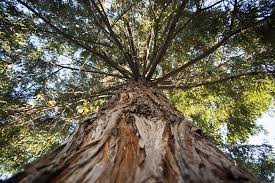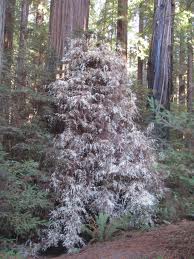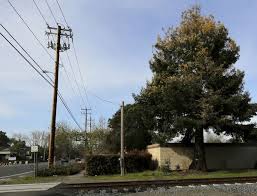Along with a colleague, I would welcome wider planting and practical use of timbers such as the California Redwood (Sequoia sempervirens) in the United Kingdom. The more we learn of these trees the more amazing they are to us.
For decades, a lone redwood has grown near the railroad tracks that run through the small city of Cotati, California. It was little noticed by most people—until officials announced that the tree had to be cut down to make way for a new transit system. Now arborists, researchers, and historians have banded together to save it.
The tree is a rarity called a chimeric albino redwood. Mixed among its normal green needles are ghostly patches of yellowish white needles. Albino redwoods have been documented since at least 1866, but they are very unusual. Amador County arborist Tom Stapleton and Colorado State University botany student Zane Moore have documented only 230 of the trees in California.
“Albinism in plants is strange because no chlorophyll means no photosynthesis, which means no life,” says Moore. A plant that completely lacks chlorophyll usually can’t survive. That’s why most albino redwoods are small, parasitic plants growing connected to a larger, healthy neighbour tree. Dave Kuty says that these redwoods are “thought to be the most adaptable tree on earth by being able to change their genes so readily… Albinos probably aren’t a particularly good modification, from the standpoint of the health of the forest, but they demonstrate there’s a lot of experimentation going on.”
Even among this rare group, the Cotati specimen is special, experts say, because it’s a chimera, combining both normal tissue and albino tissues in the same independent tree, thus growing without a neighbouring host. Moore and Stapleton know of only ten other examples, and almost all of them are stunted and relatively frail. The Cotati tree is 52 feet tall and very healthy. More surprising still, says Moore, this year it has begun producing both male and female cones—the reproductive structures of conifers—which he and other experts have never seen before.
Rare “Albino” Redwood May Hold Clues to the Super-Trees’ Longevity
Studying this unique tree could help researchers understand why albinism occurs in redwoods. Because albino and normal green needles occur on the same tree, botanists can study subtle differences between the white and the green tissue in a single specimen. “Geneticists create mutations in plants in order to study how the absence of a gene affects the overall function,” says Jarmila Pittermann, an assistant professor of ecology and evolutionary biology at Santa Cruz, who has been studying albino redwoods. “With a tree like this, we have a rare chance to study this in nature.”
Researchers at Stanford University’s DNA Sequencing Program have already collected samples from the tree for study. The California redwood’s cells hold a total of 66 chromosomes — in contrast, humans have 23 chromosomes. The multitude of chromosomes makes figuring out the mystery much more complicated. Why redwood albinos exist at all is a mystery, and seemingly unique amongst conifers. Pittermann says, “Redwoods grow to their huge size because the layer of cells that produces wood, the cambial layer, can divide for hundreds to thousands of years, that provides plenty of time for a mutation error like this to occur.”
Redwood trees are typically recognized for their awe-inspiring height. It’s common for a normal redwood tree to grow over 300 feet tall. In fact, the “Hyperion” redwood, recorded in 2006 as the world’s tallest living thing, is a towering 379 foot. However, unlike their enormous green cousins, albinos, with their limited food source and lack of chlorophyll, will never reach the heights of a regular redwood tree. Of those recorded, none have been taller than 60 foot. Despite their rarity, albino redwoods make appearances in Native American legends and ceremonies. One group that lived in Northern California—the Pomo Indians—are known to have used albino redwoods in their tribal cleansing ceremonies.
For his part, Moore thinks there may be adaptive value. “Albinos tend to be near redwood transition zones, and every one we study looks to be stressed,” he explains. “So one idea is that albinism is an adaptation to cope with stress. We’ve seen an unusual number of very young albinos coming up, which may be because of the drought that California has been experiencing.”
Whatever the cause, the existence of albinism in redwoods is “Yet another reflection of the redwood’s status as a unique species in the plant world,” Pittermann wrote in an open email urging the city of Cotati to spare the tree. “These trees may hold clues to the longevity of redwoods as well as answers to questions that we don’t yet know to ask.”
Fortunately, Sonoma Marin Area Rail Transit recently postponed plans to chop down the redwood while options are considered. Although the tree is very healthy, getting cuttings to grow has proved very difficult, says arborist Stapleton. “Right now we’re looking into the cost of moving the tree to another location.” Large trees can be safely transplanted. But Pittermann worries about moving this particular tree, because the fact that it combines normal and albino needles may make it more fragile than a normal redwood. “During times of environmental stress, like a drought, albino sprouts usually suffer first,” she says.
When contacted by National Geographic to talk about the Cotati tree, Pittermann said she hadn’t seen the specimen in person. But colleagues had sent her photos by email. When she opened the files, she was speechless for a moment. “This is incredible. I mean, this is one of a kind. This is the most impressive albino redwood that I have ever seen. It’s beautiful. I can’t think of a redwood anywhere else in the world that shows this degree of albinism. This tree has to be saved.”
Thanks to: National Geographic: Rare “Albino” Redwood May Hold Clues to the Super-Trees’ Longevity
See also: chimera (plant anatomy) — Encyclopedia Britannica
Support the Facebook campaign: Save the Rare Cotati Chimeric Albino Redwood Tree | Facebook


